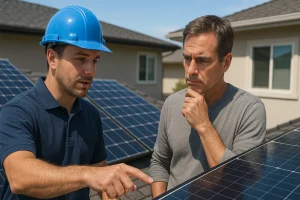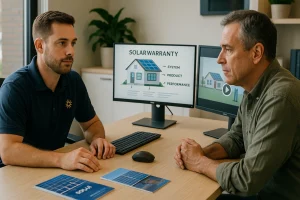Solar Warranty Communication: What Every Customer Should Know

Solar Warranty Communication: How to Improve Customer Experience in 2025
The solar industry faces a growing challenge: over 65% of customers have higher expectations for service today than three to five years ago, yet warranty communication remains one of the most overlooked aspects of the customer experience. Poor solar warranty communication leads to frustrated homeowners, overwhelmed service teams, and damaged reputations that can cost installers thousands in lost referrals. The solution lies in establishing transparent, comprehensive warranty discussions from day one that educate customers about their coverage, set realistic expectations, and create a foundation for long-term satisfaction.
Understanding Solar Warranty Communication Challenges in 2025
The solar landscape has evolved dramatically, with employment of solar photovoltaic installers projected to grow 27% between 2022 and 2032. However, this rapid growth has created communication gaps that impact customer satisfaction. Many solar businesses excel at selling solar but fall short when communicating and building positive customer experiences.

Solar warranty communication isn’t just about explaining coverage—it’s about managing expectations throughout the system’s 25-year lifespan. When customers understand their warranty coverage upfront, they’re less likely to become frustrated with normal system behaviors or contact support unnecessarily.
Essential Solar Warranty Types Customers Must Understand
Product Warranty Coverage and Customer Expectations
Most manufacturers offer at least 10 years of coverage under a product warranty, while some premium options have 25 or even 30+ years of protection. Your customers need to understand that product warranties cover manufacturing defects, not performance degradation or damage from external factors.
Clear communication about product warranty limitations prevents future disputes. Explain that solar panel warranties typically won’t reimburse for labor costs associated with installing new equipment or shipping fees. This transparency builds trust and eliminates surprise costs down the road.
Performance Warranty Communication Best Practices
Performance warranties guarantee energy production levels, but customers often misunderstand what “normal degradation” means. Most solar panel manufacturers guarantee at least 80% of original output by the end of the warranty term, or about 0.7% degradation each year.
Effective solar warranty communication includes explaining that panels degrade at the highest rate when first exposed to solar radiation, with 2-3% degradation in the first year being normal. After the initial adjustment period, degradation levels off to a more stable rate.
Workmanship Warranty Customer Disclosure Requirements
Workmanship warranties protect against installation-related issues, but coverage varies significantly between installers. A reputable solar installer should offer a 25-year equipment warranty and a 10-year workmanship warranty, though some premium installers now offer extended terms.

Your warranty communication should clearly outline what constitutes covered workmanship issues versus normal maintenance requirements. This prevents customer confusion when routine maintenance needs arise.
Revolutionary Warranty Developments in 2025
The solar warranty landscape is experiencing significant changes. Solar Insure announced a new 30-year battery warranty product for installers to offer residential solar customers, addressing the shorter lifespan of battery storage systems compared to solar panels.
This development represents a major shift in warranty communication strategy. Battery attachment rates in residential solar installations have increased steadily from about 8.1% in 2020 to around one-in-four systems today, making comprehensive battery warranty communication essential for modern installers.
Proactive Solar Warranty Communication Strategies
Setting Realistic Customer Expectations Upfront
Trust is developed and misconceptions are avoided when project schedules, anticipated difficulties, and realistic outcomes are openly discussed. Your initial warranty discussion should cover not just what’s included, but what customers can expect throughout their system’s lifetime.
Effective solar warranty communication includes explaining maintenance requirements, monitoring expectations, and the process for addressing potential issues. Solar providers can guarantee clients understand the system’s performance, maintenance needs, and warranty coverage by establishing reasonable expectations upfront.
Implementing Customer Education Systems
Modern customers expect immediate answers to their questions. Consumers are used to getting their questions answered immediately, often through online chat features and customer portals. Developing comprehensive warranty education materials reduces support burden while improving customer satisfaction.
Consider creating visual guides, FAQ documents, and video explanations that customers can reference

throughout their system’s lifetime. This proactive approach to solar warranty communication demonstrates professionalism and reduces reactive support requests.
Technology-Enhanced Warranty Communication
Smart warranty communication involves leveraging technology to keep customers informed. Solar customer experience platforms can help installers level up their communications by automating many of the answers to common homeowner questions.
Automated warranty reminders, performance alerts, and educational content delivery create a seamless customer experience while reducing your team’s workload. These systems also ensure consistent messaging across all customer touchpoints.
Avoiding Common Solar Warranty Communication Pitfalls
Managing Growth-Related Communication Challenges
As your sales team closes more deals, your cumulative customer base and service pipeline starts to balloon, with customer issues often growing faster than existing support structures can handle. Scalable warranty communication systems become critical as your business grows.
Develop standardized warranty communication protocols that maintain quality regardless of your team size. This includes templated explanations, visual aids, and clear escalation procedures for complex warranty issues.
Preventing Warranty Claim Confusion
New hires struggle, customers get inconsistent answers, and trust erodes when warranty communication lacks standardization. Train your team thoroughly on all warranty types and ensure consistent messaging across all customer interactions.
Building Long-Term Customer Relationships Through Warranty Communication
Effective solar warranty communication extends far beyond installation completion. Solar providers can empower clients to optimize their solar systems and get the most advantages by offering ongoing assistance and instructional materials.
Consider warranty communication as relationship-building rather than obligation fulfillment. Customers who understand their warranties become advocates for your business, generating valuable referrals and positive reviews.
Conclusion: Energyscape Renewables’ Commitment to Transparent Warranty Communication
Exceptional solar warranty communication separates industry leaders from the competition. At Energyscape Renewables, we understand that informed customers become satisfied long-term partners. Our comprehensive warranty communication process ensures every customer understands their coverage, knows what to expect, and feels confident in their solar investment.
We work closely with industry leaders and utilize resources like Sunscape Solar to stay current with evolving warranty standards and best practices. This commitment to transparency and education drives our customer satisfaction rates and positions us as a trusted partner in your solar journey.
By implementing robust warranty communication strategies, you’re not just selling solar systems—you’re building lasting relationships that drive sustainable business growth through referrals, positive reviews, and repeat customers.

sjayakanth@energyscaperenewables.com